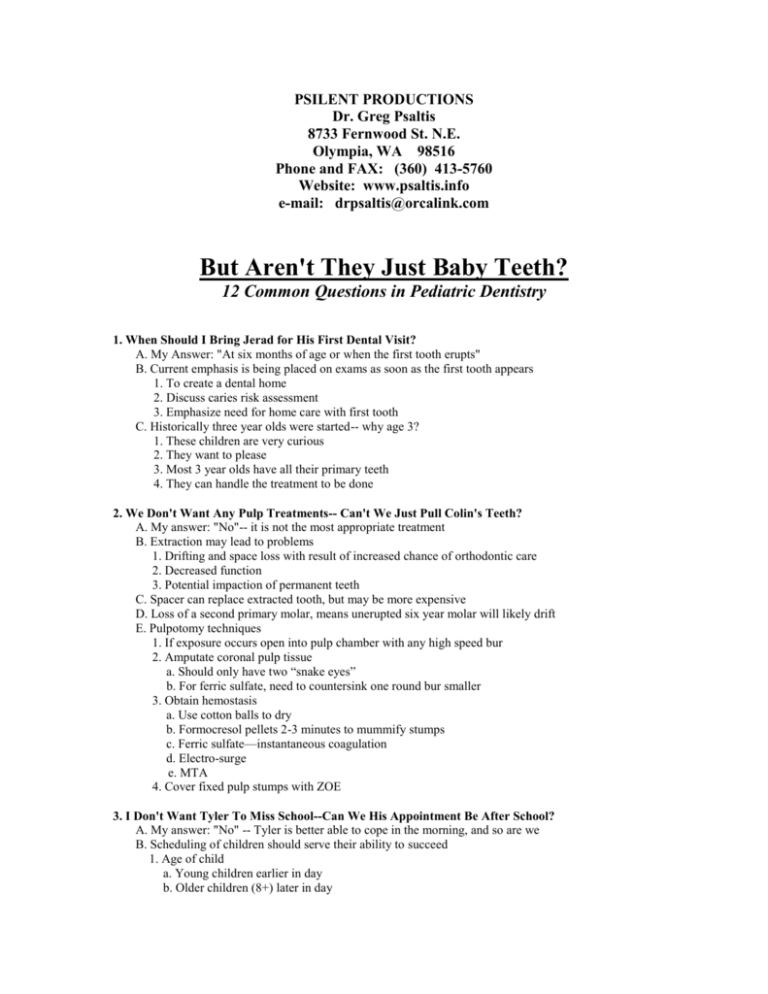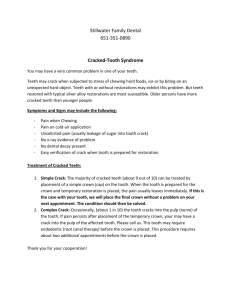PSILENT PRODUCTIONS
advertisement

PSILENT PRODUCTIONS Dr. Greg Psaltis 8733 Fernwood St. N.E. Olympia, WA 98516 Phone and FAX: (360) 413-5760 Website: www.psaltis.info e-mail: drpsaltis@orcalink.com But Aren't They Just Baby Teeth? 12 Common Questions in Pediatric Dentistry 1. When Should I Bring Jerad for His First Dental Visit? A. My Answer: "At six months of age or when the first tooth erupts" B. Current emphasis is being placed on exams as soon as the first tooth appears 1. To create a dental home 2. Discuss caries risk assessment 3. Emphasize need for home care with first tooth C. Historically three year olds were started-- why age 3? 1. These children are very curious 2. They want to please 3. Most 3 year olds have all their primary teeth 4. They can handle the treatment to be done 2. We Don't Want Any Pulp Treatments-- Can't We Just Pull Colin's Teeth? A. My answer: "No"-- it is not the most appropriate treatment B. Extraction may lead to problems 1. Drifting and space loss with result of increased chance of orthodontic care 2. Decreased function 3. Potential impaction of permanent teeth C. Spacer can replace extracted tooth, but may be more expensive D. Loss of a second primary molar, means unerupted six year molar will likely drift E. Pulpotomy techniques 1. If exposure occurs open into pulp chamber with any high speed bur 2. Amputate coronal pulp tissue a. Should only have two “snake eyes” b. For ferric sulfate, need to countersink one round bur smaller 3. Obtain hemostasis a. Use cotton balls to dry b. Formocresol pellets 2-3 minutes to mummify stumps c. Ferric sulfate—instantaneous coagulation d. Electro-surge e. MTA 4. Cover fixed pulp stumps with ZOE 3. I Don't Want Tyler To Miss School--Can We His Appointment Be After School? A. My answer: "No" -- Tyler is better able to cope in the morning, and so are we B. Scheduling of children should serve their ability to succeed 1. Age of child a. Young children earlier in day b. Older children (8+) later in day c. Teenagers after school 2. Length of appointment a. Usually 30-45 minutes b. Want to complete all treatment in 3 or fewer appointments 3. Type of visit (procedures to be done) a. Sedation and heavier restorative visits earlier in day b. Simpler restorative visits later in mornings or early afternoon c. 6 month checkups anytime in day 4. How Will Megan Do When You Fill Her Tooth? A. My Answer: "Fine" B. What to say" 1. Be realistic 2. Be optimistic 3. Be clear and layout out guidelines for parents a. Do not overprepare child or frighten them b. Use our terminology c. Be an observer only d. Leave when asked 5. Heather Bumped Her Front Tooth and It's Dark-- Is It Dead? A. My Answer: "Probably Not" B. Most primary teeth heal normally without treatment C. What is normal? 1. Bleeding 2. Swelling 3. Mobility 4. Pain 5. Darkening of tooth-- usually progresses for about 6-8 weeks and eventually lightens back up D. What won't heal normally? 1. Root fractures 2. Avulsions-- partial and complete 3. Severe displacements 4. Internal resorption 6. Aren't They Just Baby Teeth? A. My Answer: "Yes" B. Reasons to move ahead with treatment though 1. Primary teeth provide function of chewing during years of greatest body growth 2. Esthetically, they provide an attractive appearance and smile 3. They play a role in speech 4. Permanent tooth guidance is greatly effected by primary teeth C. Longevity of primary teeth 1. Permanent incisors and first molars usually erupt between 6-7 1/2 years of age 2. Permanent cuspids and biscuspids usually erupt between 10-13 years of age 7. Marlene Never Eats Any Sugar-- How Can She Have 8 Cavities? A. My answer: "It's common"-- it may have to do with the nature of the snack foods B. Cariogenicity of foods 1. Sugar content is generally well known 2. Frequency is not as often understood by parents 3. Physical properties, such as stickiness is rarely known a. Fruit rollups b. Raisins c. Gummy bears, etc. 2 8. Will You Put Sealants on Bob's Baby Teeth? A. My answer: "No"-- success on primary teeth is not as great B. Statistics 1. 70 percent of caries in primary teeth occur interproximally 2. Retentiveness in broader and shallower grooves is not as predictable C. Sealants on permanent teeth 1. We always use a rubber dam to isolate and keep dry 2. We use topical anesthetic for placement of clamps 3. Cleaning of grooves is done by air abrasion 4. Etching is brief 5. Unfilled bonding agent is used to increase flow of filled sealant material 6. Filled sealant material will increase strength and wear resistance 9. I Want A Good Experience For My Child Without Sedation, Restraint or Verbal A. My answer: "Yes and no"-- this will depend on the child and the situation B. For very young, anxious child with large treatment plan= "No" C. For older children and/or small treatment plans= "Yes" D. What to say 1. Be honest 2. Be realistic 3. Discuss all possibilities E. These parents probably don't need much to be disappointed or angry 10. Does Madison Really Need a Space Maintainer? A. Band and Loop 1. Unilateral single tooth loss 2. First primary molar space 3. Can be used in either dental arch B. Lingual Arch 1. Bilateral mandibular tooth loss 2. Unilateral multiple tooth loss in mandible 3. Single second primary molar loss in mandible C. Nance Appliance 1. Bilateral maxillary tooth loss 2. Unilateral multiple tooth loss in maxilla 3. Single second primary molar loss in maxilla 11. How Soon Should I Start Brushing Beth's Teeth? A. My answer: "As soon as the first teeth erupt into the mouth" B. Some tips to increase success 1. Start with Q-Tip, washcloth or “Tenders” 2. Recommend that the parent let the child watch the parent brush 3. Avoid strongly flavored toothpastes, especially mint flavored, which is "hot" 4. May want to use child in parents' lap technique C. This is also an opportunity to educate parents about fluoride, diet and checkups 12. Daniel's Teeth Just Came in Rotten-- Does He Have Soft Teeth? A. My answer: "No" (sometimes the case, but Daniel doesn't fit a usual pattern) B. Nature of the problem 1. Is it generalized or only in a limited area? 2. Any changes in the shape and size of root canals? 3. Is it removeable or intrinsic? C. Bottle syndrome D. Enamel hypoplasia E. Intrinsic stains 3






